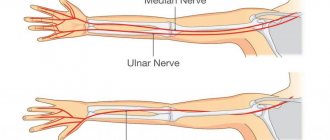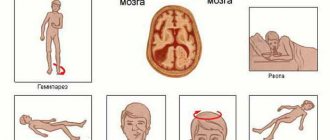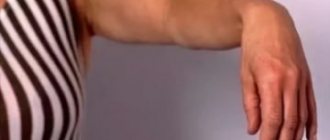Everyone is familiar with the feeling of sharp pain as a result of an elbow strike. It’s as if an electric current shoots through the arm from the elbow joint to the little finger, sometimes radiating up the shoulder. This occurs due to contusion of the ulnar nerve. Compression of the nerve at the elbow joint is called cubital tunnel syndrome or cubital tunnel syndrome.
The disease is the second most common among carpal tunnel syndromes, second only to carpal tunnel syndrome.
Anatomy of the ulnar nerve and cubital tunnel
The ulnar nerve originates in the cervical plexus, being one of the three main nerves of the upper limb. It runs along the inner surface of the shoulder, then lies in the canal formed by the olecranon process, the internal epicondyle and the ligament that connects these two bone formations, forming a rather narrow cubital canal.
Next, the nerve passes through the intermuscular space of the forearm, flowing into another channel, this time on the wrist. This canal is called the Guyon Canal. It is at the level of this canal that the ulnar nerve begins to divide into 3, sometimes 4 branches, ending with the sensory branches of the 5th and inner half of the 4th fingers, as well as the motor branches of the 3-4-5 lumbrical muscles of the hand.
Symptoms of pain
The main symptom of elbow disease is pain.
The following signs are typical for the traumatic group of injuries:
- Piercing pain at the time of injury
- Swelling and hematoma in the elbow joint
- Elbow deformity
- Restrictions in arm movements, partial or complete loss of limb function
- Or pathological mobility and the possibility of movements atypical for the elbow
- Numbness or tingling in the forearm, wrist, or hand
- Creaking or clicking noise when moving your elbow
- Any discoloration of the skin in the area of injury
- Palpable protrusion of bone fragments under the surface of the skin
If any of the above symptoms occur, you should immediately seek help from the traumatology department.
Causes of cubital tunnel syndrome
The cause of this particular disease is compression of the nerve in the cubital canal. In this article we do not discuss nerve injury.
There are several causes of cubital tunnel syndrome:
- repeated trauma to the ligaments and bone structures of the elbow joint that form the canal,
- intense sports,
- arthritis, arthrosis of the elbow joint
- synovitis of the elbow joint or hemarthrosis
- repeated monotonous activities,
- consequences of fractures can also be the causes of the syndrome.
For drivers, the disease can be caused by the habit of placing their elbow on the window opening of the car door. When symptoms appear, this habit will have to be eradicated.
At the computer, you should pay attention to the position of your hand when working on the keyboard and mouse. When doing this type of work, the forearm should rest completely on the tabletop. You can put something soft under the sore elbow.
Compression of the ulnar nerve in the canal can be caused by inflammatory processes not only in the nerve tissue, but also in the soft tissue component of the cubital canal wall. For example, with medial epicondylitis, inflammation in the projection of the internal epicondyle can cause swelling and compression of the nerve. Failure to consult a doctor in a timely manner and delays in starting treatment can lead to organic damage to the wall and the process becoming chronic. As a result of the thickening of the nerve sheath, the transmission of nerve impulses may become difficult, leading to loss of sensation and motor function in some muscles of the hand and forearm.
The most likely causes of pain in the elbow joint
Pain in the elbow joint is usually understood as specific unpleasant sensations of varying intensity, indicating the course of pathological processes localized in the joint, as well as the tissues surrounding it.
It is customary to identify several groups of the most likely causes of pain in a large joint of the upper extremities. Let's try to study them in more detail.
Traumatic elbow injury
One of the causes of pain when flexing/extending the elbow joint can be an injury, for example, a bruise that occurs after a blow of varying force or a fall with the upper limb supported.
Considering other traumatic injuries, one can also note a periarticular or intra-articular fracture, accompanied by sharp pain, the intensity of which gradually decreases, but with mobility of the joint it increases again.
Pain in the elbow joint can also occur when the bones of the forearm are dislocated, which is also accompanied by severe, literally unbearable pain, as well as a clicking or crunching sound when injured.
Development of inflammatory processes
One of the most common inflammations of the joint is various types of arthritis, accompanied by dull, wave-like pain that intensifies during night rest.
In the absence of timely treatment, a more complex form of pathology may occur - purulent arthritis, aggravated by local swelling, as well as a significant increase in body temperature and the presence of symptoms of general intoxication.
Special attention should be paid to such an inflammatory process as post-traumatic osteomyelitis, the likelihood of which is most likely to develop with open injuries, which also include surgical intervention.
Soft tissue pathologies
Pain in the elbow joint can occur due to the development of bursitis (inflammation accompanied by damage to the synovial bursa). Both acute and chronic forms can occur, each of which has a specific symptomatic picture.
Also among the soft tissue pathologies that can cause pain in the upper limb is synovitis (inflammation of the joint membrane with the accumulation of fluid in its cavity). According to the clinical picture of the pathology, it acts as a secondary disease and develops with injuries or the development of other joint diseases.
Degenerative-dystrophic processes localized in the area of attachment of tendons, ligaments and joint capsule to the bone - enthesopathy
Enthesopathies are among the inflammatory-degenerative diseases, in which pain in the joint migrates from the shoulder to the forearm. It is important to note that a cause of this kind is accompanied by increased pain in the elbow joint during exercise and is combined with an increase in weakness of the hand apparatus.
Among the pathological processes of this type, it is also customary to include medial epicondylitis (inflammatory damage to the tendons). This kind of illness often occurs in people who lead a sports career, as well as in those who daily perform similar movements with their upper limbs (seamstresses, etc.).
Degenerative diseases
The most common degenerative disease that can cause hand pain is arthrosis. As the pathology progresses, the pain intensifies and becomes more pronounced, which may also be accompanied by stiffness and a characteristic “crunching” sensation.
Chondromatosis should also be included in this category, in which loose bodies are formed in the joint capsule that can not only migrate into the articular cavity, but also interfere with movement, which significantly increases pain.
Autoimmune pathologies
Particular attention should be paid to a group of autoimmune diseases, for example, rheumatoid arthritis. Pain with this type of diagnosis directly depends on the degree of activity of the destructive process.
Symmetrical pain in the elbows of the upper extremities can be observed with systemic lupus erythematosus. The less progressive the disease, the less pain.
In addition, pain in the elbow joint of the right or left hand, and sometimes even in both, can occur with rheumatism, when there is multiple damage to the joint of the musculoskeletal system.
Benign/malignant formations
Neoplasia (the emergence and gradual development of new tissue) is another likely cause of pain. The pain syndrome, as a rule, has insignificant intensity, but is determined in a fairly precise localization. As the tumor grows, the pain increases and the risk of migration is high.
Formations of a malignant type are manifested by the most striking and intensely developing pain syndrome. At the final stage, the pain becomes literally unbearable, permanent, excruciating.
Other
Pain in two upper extremities at once, only in the right elbow or exclusively in the left can occur due to a large number of reasons. Some of the most probable ones are separated into separate groups based on a common feature. However, there is a list of causes of pain in the elbow joint that fall into the “other” category, which usually include:
- ulnar nerve neuropathy;
- cubital tunnel syndrome;
- diseases of the cervical spine;
- IHD (coronary heart disease);
- myocardial infarction;
- mental disorders of various types;
- depressive states;
- taking medication (in particular, corticosteroids and anabolic steroids).
Signs and symptoms of cubital tunnel syndrome
Symptoms of cubital tunnel syndrome include each of the following:
It is not necessary to have all the signs.
- Stiffness, loss of sensation, or significant dull or sharp pain in the ulnar part of the hand, 4th and 5th fingers.
- Pain and weakness when attempting to grasp an object with a brush.
- Discomfort in the elbow area.
Such symptoms indicate ischemia (lack of blood supply) of the nervous tissue. These symptoms are most pronounced in the morning, after the hand has been resting overnight. After some time, when the patient performs a certain amount of movements, the pain and numbness slightly recedes.
Classification of pain in the elbow joint and features of their manifestation
Classification of pain symptoms localized in the elbow can be carried out depending on its characteristics and area of occurrence:
- Pain in the elbow joint when bending appears with traumatic tendon ruptures, as well as with arthrosis, arthritis and bursitis;
- Pain when extending the elbow joint can appear for the above reasons, as well as with epicondylitis, when the patient cannot hold an object on an outstretched upper limb or clench his hand into a fist;
- Painful symptoms on the inside can be a sign of epicondylitis or injury.
Another type of classification is based on the nature of pain. They can be:
- reflected - with an initiating factor in the form of diseases of internal organs;
- projected - appear due to injuries or compression of the spinal canal;
- acute - for serious injuries, including fractures and ligament ruptures;
- burning - caused by inflammatory processes of nerve endings, gout;
- dull - due to tumors of malignant etiology or destruction of cartilage tissue.
Diagnosis of cubital tunnel syndrome
When examining the elbow joint by a doctor, the patient may notice a significant increase in pain. A painful examination is necessary for a specialist to make an accurate diagnosis:
- If the nerve is compressed in the canal, there will be a positive Tinnel's sign, which is manifested by the sensation of a current shooting through the nerve into the little and ring fingers when the doctor taps with a neurological hammer - although this can happen when the nerve is without pathology, with a strong blow.
- The doctor will check to see if the nerve slips out of the canal when the patient bends the arm at the elbow.
- Tests sensitivity and strength in the hand and fingers.
If the doctor has doubts about the causes of cubital tunnel syndrome, the patient may be recommended to undergo additional examinations, such as MRI, ENMG, and radiography.
Radiography. Based on radiographs, it is possible to determine bone exostoses in the projection of the canal, which compress the nerve. But most of the causes of compression of the ulnar nerve cannot be seen on x-ray, since they are of soft tissue etiopathogenesis.
Electroneuromyography (ENMG). This study makes it possible to determine how well the impulses are transmitted along the nerve and to determine at what level and how much the nerve is compressed.
During nerve conduction testing, the nerve is stimulated proximally and the time required to conduct the impulse is measured and compared with normal values.
Read also
Periarthrosis or periarthritis?
Let's imagine that you are driving a luxury car along our wonderful roads and suddenly notice that something persistently creaks in the area of the front wheel on the right.
Moreover, this creaking intensifies periodically,… Read more
Osteoarthritis of the hip joint
In the vast majority of cases, this diagnosis can be suspected when the patient first enters the doctor’s office. The patient spares the affected leg, limping on it, transferring his body weight to the healthy leg, and...
More details
Pain on the inside of the knee and sphenoid neuralgia
Clinical manifestation of pain on the inside of the knee and sphenoid neuralgia Sphenoid neuralgia is usually observed when the nerve passes through Gunter's canal, or what...
More details
Heel spur
Have you been bothered by pain in your heel when walking for some time (or maybe quite a long time)? The feeling of stepping on a sharp nail or pebble, constant discomfort and unpleasant sensations during…
More details
Contracture
A fairly powerful word to hear, denoting the lack of full range of motion in a joint. The most common causes are prolonged immobilization of the joint. This is possible when after...
More details
Treatment of cubital tunnel syndrome
The vast majority of such cases of the disease require non-surgical treatment. Non-surgical treatment options for cubital tunnel syndrome include:
- load reduction,
- temporary refusal of intense training,
- taking anti-inflammatory non-hormonal drugs.
Good remedies for treating cubital tunnel syndrome are anti-inflammatory non-steroidal ointments, taking vitamins and the patient undergoing a course of physiotherapy.
Surgical treatment of cubital tunnel syndrome is prescribed if therapeutic methods have not produced results after 12 weeks. During surgery, segments of the canal wall are removed from the patient and the tendon arches are cut. If it is impossible to expand the canal surgically, the nerve is completely removed from it, placing it between muscle tissue and fatty tissue.
Treatment Options
Treatment largely depends on the type and nature of the fracture in the elbow joint. For non-displaced fractures (for example, the olecranon), conservative treatment can be achieved by applying a fixing plaster cast for several weeks. If a joint has been displaced, then the issue of surgical intervention is decided. To do this, reposition the fragments (closed or open). With open comparisons, surgical fixation of fragments is required; this operation is called osteosynthesis. Osteosynthesis is the joining of bone fragments using special fixing agents (bone grafts or metal structures). If the fractures of the articular part of the humerus are fragmented, then it is possible to replace the elbow joint with a prosthesis. To restore the function of the elbow joint in case of deforming arthrosis, as well as in congenital and acquired deformities and contractures of other etiologies, osteotomy is currently performed. Osteotomy is a surgical operation that helps eliminate deformation of the elbow joint or improve the function of the musculoskeletal system through an artificial fracture with further fixation to give a functionally advantageous position. After any surgical intervention, the patient is prescribed rehabilitation measures drawn up by the attending physician individually for each person.









